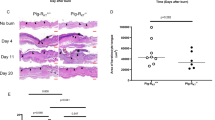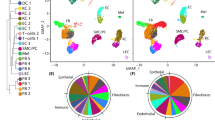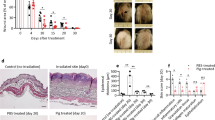Abstract
Activation of plasminogen (Plg) has been proposed to play a role in proteolytic degradation of extracellular matrices in tissue remodeling events, including wound healing. However, there has been no definitive proof of involvement of Plg in such processes. We now report that healing of skin wounds is severely impaired in mice made deficient in Plg by targeted gene disruption. The results demonstrate that Plg is required for normal repair of skin wounds in mice and support the assumption that it also plays a central role in other disease processes involving extracellular matrix degradation, such as cancer invasion.
This is a preview of subscription content, access via your institution
Access options
Subscribe to this journal
Receive 12 print issues and online access
$209.00 per year
only $17.42 per issue
Buy this article
- Purchase on Springer Link
- Instant access to full article PDF
Prices may be subject to local taxes which are calculated during checkout
Similar content being viewed by others
References
Blasi, F., Vassalli, J.-D. & Danø, K. Urokinase-type plasminogen activator: Proenzyme, plasma membrane binding site and inhibitors. J. Cell Biol. 104, 801–804 (1987).
Saksela, O. & Rifkin, D.B. Cell-associated plasminogen activation: Regulation and physiological functions. Annu. Rev. Cell Biol. 4, 93–126 (1988).
Vassalli, J.-D. Sappino, A.P. & Belin, D. The plasminogen activator/plasmin system. J. Clin. Invest. 88, 1067–1072 (1991).
Danø, K. et al. The urokinase receptor. Protein structure and role in plasminogen activation and cancer invasion. Fibrinolysis 8, 189–203 (1994).
Collen, D. Towards improved thrombolytic therapy. Lancet 342, 34–36 (1993).
Beers, W.H., Strickland, S. & Reich, E. Ovarian plasminogen activator: Relationship to ovulation and hormonal regulation. Cell 6, 387–394 (1975).
Ossowski, L., Biegel, D. & Reich, E. Mammary plasminogen activator: Correlation with involution, hormonal modulation and comparison between normal and neoplastic tissue. Cell 16, 929–940 (1979).
Ny, T., Bjersing, L., Hsueh, A.J.W. & Loskutoff, D.J. Cultured granulosa cells produce two plasminogen activators and an antiactivator, each regulated differently by gonadotropinsa. Endocrinology 116, 1666–1668 (1985).
Sappino, A.P., Huarte, J., Belin, D. & Vassalli, J.-D. Plasminogen activators in tissue remodeling and invasion-messenger RNA localization in mouse ovaries and implanting embryos. J. Cell Biol. 109, 2471–2479 (1989).
Talhouk, R.S., Bissell, M.J. & Werb, Z. Coordinated expression of extracellular matrix-degrading proteinases and their inhibitors regulates mammary epithelial function during involution. J. Cell Biol. 118, 1271–1282 (1992).
Morioka, S., Lazarus, G.S., Baird, J.L. & Jensen, P.L. Migrating keratinocyes express urokinase-type plasminogen activator. J. Invest. Dermatol. 88, 418–423 (1987).
Grondahl-Hansen, J., Lund, L.R., Ralfkiaer, E., Ottevanger, V. & Danø, K. Urokinase-and tissue-type plasminogen activators in keratinocytes during wound reepithelialization in vivo. J. Invest. Dermatol. 90, 790–795 (1988).
Rømer, J. et al. Differential expression of urokinase-type plasminogen activator and its type-1 inhibitor during healing of mouse skin wounds. J. Invest. Dermatol. 97, 803–811 (1991).
Rømer, J. et al. The receptor for urokinase-type plasminogen activator is expressed by keratinocytes at the leading edge during re-epithelialization of mouse skin wounds. J. Invest. Dermatol. 102, 519–522 (1994).
Schäfer, B.M., Maier, K., Eickhoff, U., Todd, R.F. & Kramer, M.D. Plasminogen activation in healing human wounds. Am. J. Pathol. 144, 1269–1280 (1994).
Pepper, M.S., Vassalli, J.-D. Montesano, R. & Orci, L. Urokinase-type plasminogen activator is induced in migrating capillary endothelial cells. J. Cell Biol. 105, 2535–2541 (1987).
Pepper, M.S. et al. Upregulation of urokinase receptor expression on migrating endothelial cells. J. Cell Biol. 122, 673–684 (1993).
Danø, K. et al. Plasminogen activators, tissue degradation, and cancer. Adv. Cancer Res. 44, 139–266 (1985).
Ossowski, L. Plasminogen activator dependent pathways in the dissemination of human tumor cells in the chick embryo. Cell 52, 321–328 (1988).
Liotta, L.A., Steeg, P.S. & Stetler-Stevenson, W.G. Cancer metastasis and angiogenesis: an imbalance of positive and negative regulation. Cell 64, 327–336 (1991).
Pyke, C. et al. Urokinase-type plasminogen activator is expressed in stromal cells and its receptor in cancer cells at invasive foci in human colon adenocar-cinomas. Am. J. Pathol. 138, 1059–1067 (1991).
Crowley, C.W. et al. Prevention of metastasis by inhibition of the urokinase receptor. Proc. Natl. Acad. Sci. USA 90, 5021–5025 (1993).
Heiss, M.M. et al. Individual development and uPA-receptor expression of disseminated tumour cells in bone marrow: A reference to early systemic disease in solid cancer. Nature Med. 1, 1035–39 (1995).
Bugge, T.H., Flick, M.J., Daugherty, C.C. & Degen, J.L. Plasminogen deficiency causes severe thrombosis but is compatible with development and reproduction. Genes Dev. 9, 794–807 (1995).
Clark, R.A.F. & Henson, P.M., eds. The Molecular and Cellular Biology of Wound Repair (Plenum, New York, 1988).
Donaldson, D.J. & Mahan, J.T. Keratinocyte migration and the extracellular matrix. J. Invest. Dermatol. 90, 623–628 (1988).
Unkeless, J.C., Gordon, S. & Reich, E. Secretion of plasminogen activator by stimulated macrophages. J. Exp. Med. 139, 834–850 (1974).
Heiple, J.M. & Ossowski, L. Human neutrophil plasminogen activator is localized in specific granules and is translocated to the cell surface by exocytosis. J. Exp. Med. 164, 826–840 (1986).
Pöllanen, J., Hedman, K., Nielsen, L.S., Danø, K. & Vaheri, A. Ultrastructural localization of plasma membrane-associated urokinase-type plasminogen activator at focal contacts. J. Cell Biol. 106, 87–95 (1988).
Vassalli, J.-D. Wohlwend, A. & Belin, D. Urokinase-catalyzed plasminogen activation at the monocyte/macrophage cell surface: A localized and regulated proteolytic system. Cur. Top. Microbiol. Immunol. 181, 65–86 (1992).
Salo, T., Makela, M., Kylmaniemi, M., Autio-Harmainen, H. & Larjava, H. Expression of matrix metalloproteinase-2 and -9 during early human wound healing. Lab. Invest. 70, 176–182 (1994).
Inoue, M., Kratz, G., Haegerstrand, A. & Stahle-Backdahl, M. Collagenase expression is rapidly induced in wound-edge keratinocytes after acute injury in human skin, persists during healing, and stops at re-epithelialization. J. Invest. Dermatol. 104, 479–483 (1995).
Saarialho-Kere, U.K. et al. Interstitial collagenase is expressed by keratinocytes that are actively involved in reepithelialization in blistering skin disease. J. Invest. Dermatol. 104, 982–988 (1995).
Werb, Z., Mainardi, C., Vater, C.A. & Harris, E.D. Endogenous activation of latent collagenase by rheumatoid synovial cells. N. Engl. J. Med. 296, 1017–1023 (1977).
Mignatti, P. & Rifkin, D.B. Biology and biochemistry of proteinases in tumor invasion. Physiol. Rev. 73, 161–195 (1993).
Grainger, D.J., Kemp, P.R., Liu, A.C., Lawn, R.M. & Metcalfe, J.C. Activation of transforming growth factor-beta is inhibited in transgenic apolipoprotein(a) mice. Nature 370, 460–462 (1994).
Suh, T. et al. Resolution of spontaneous bleeding events but failure of pregnancy in fibrinogen-deficient mice. Genes Dev. 9, 2020–2033 (1995).
Carmeliet, P. et al. Physiological consequences of loss of plasminogen activator gene function in mice. Nature 368, 419–424 (1994).
Dvorak, H.F. Tumors: Wounds that do not heal. Similarities between tumor stroma generation and wound healing. N. Engl. J. Med. 315, 1650–1659 (1986).
Prendergast, G.C., Diamond, L.E., Dahl, D. & Cole, M.D. The c-myc-regulated gene mrl encodes plasminogen activator inhibitor 1. Mol. Cell. Biol. 10, 1265–1269 (1990).
Author information
Authors and Affiliations
Rights and permissions
About this article
Cite this article
Rømer, J., Bugge, T., Fyke, C. et al. Impaired wound healing in mice with a disrupted plasminogen gene. Nat Med 2, 287–292 (1996). https://doi.org/10.1038/nm0396-287
Received:
Accepted:
Issue Date:
DOI: https://doi.org/10.1038/nm0396-287
This article is cited by
-
Tranexamic acid for haemostasis and beyond: does dose matter?
Thrombosis Journal (2023)
-
Enhanced Expression of Plasminogen Activators and Inhibitor in the Healing of Tympanic Membrane Perforation in Rats
Journal of the Association for Research in Otolaryngology (2023)
-
Serpin-loaded extracellular vesicles promote tissue repair in a mouse model of impaired wound healing
Journal of Nanobiotechnology (2022)
-
Roles of fibrinolytic factors in the alterations in bone marrow hematopoietic stem/progenitor cells during bone repair
Inflammation and Regeneration (2020)
-
The plasminogen receptor, Plg-RKT, plays a role in inflammation and fibrinolysis during cutaneous wound healing in mice
Cell Death & Disease (2020)



